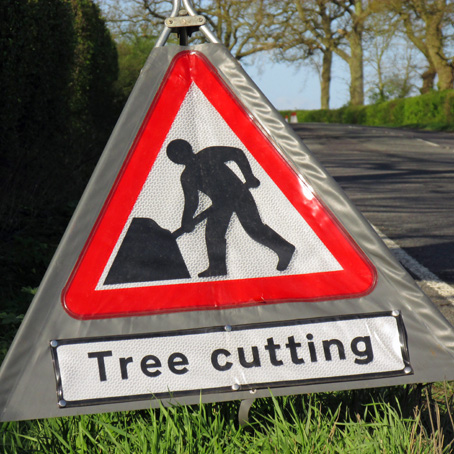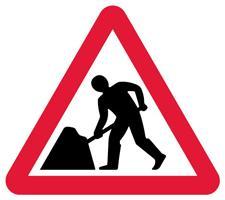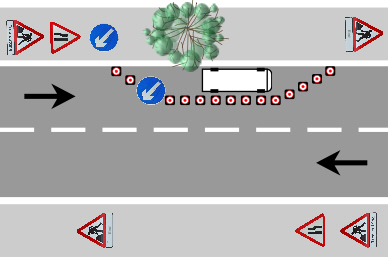
A Guide to Chapter 8 in the Traffic Signs Manual
Chapter 8 in the government’s official Traffic Signs Manual relates to ‘Traffic Safety Measures and Signs for Road Works and Temporary Situations’. Whilst it is not statutory (except in Northern Ireland) it does set out a code of practice that facilitates the legal requirements covered by various legal regulations including the New Roads and Street Works Act 1991, the Traffic Signs Regulations and General Directions (TSRGD) and the Highways Act 1980.
It goes without saying that Chapter 8 is of significant importance to tree surgeons and arborists, who are often temporarily working on the roadside. Due to the nature of the work, appropriate signage and sign placement is essential for the safety of road users and pedestrians.
In this guide, I want to give a broad overview of Chapter 8 for arborists and tree surgeons.
Guiding Principles in Chapter 8 Traffic Management Planning
There are two principles that guide all temporary traffic management design. The primary objective is always to ensure the safety of your workforce and the travelling public. The secondary objective is to keep traffic moving as freely as possible. As such a full risk assessment needs to be carried out at all stages of the works or project.
Once safety has been taken into consideration there are several other factors at play that will affect the planning stage:
- The needs of pedestrians
- Length of works
- Liaison with the local Highway Authority
- Holidays or busy periods
- Public transport routes
- Police and emergency services access
Site Information
Of special interest to planners of tree work or removal will be information about the site itself, such as any buildings or other structures that may impede or slow the work. If a tree is being removed then it’s important to have information on peak traffic periods, pedestrian usage and alternative routes for diverted traffic as road lanes or the footpath may need to be closed. Other important information includes:
- Information on existing safety barriers
- The location and nature of existing permanent signs and road markings
- Needs of local businesses or residents
- Accident records
- Railway or tram restrictions
- Susceptibility to flooding
- Location of overhead power lines
- Presence of underground or overground services
Signing Principles
Signs should always be placed where they are most visible to those who need to read them (road users and/or pedestrians) but without causing an inconvenience or a danger to anyone using the road or footpath. If there is a grass verge then this is usually considered a good location.
Depending on the extent and potential disruption of any tree work being carried out signs can include traffic management signs, regulatory signs, warning signs, driver information signs and when necessary diversion signs. All Chapter 8 traffic signs must comply with TSRGD 2002 unless they have proper authority from the Department of Transport and Highways Agency.
All temporary roadworks sites need to have the approved roadworks sign (see below) in situ as the first sign that drivers come across, at all approaches to the works.

In the case of tree work, it is recommended that the sign is also supplemented with an additional plate that reads “Tree Cutting”. A basic work zone requires a minimum of 8 signs as follows:
- Man at Work sign (as shown above), ideally with a plate describing the nature of the works
- A ‘road narrows’ sign, showing which lane is about to narrow
- Arrow signs should be placed to guide traffic around the coned-off work zone
- A Man at Work sign with an ‘End’ plate after the works
- The same configuration of signs should be placed correspondingly on the opposite carriageway or lane for traffic travelling in the other direction, although arrow signs are not needed if the traffic has full use of their lane

Other signs may be required depending on the position and layout of the site, for example showing distance to works, distance over which the works extend or the road name (ie M4, A36). You’ll also need to consider whether Stop/Go boards or traffic lights are necessary.
Sign Sizes
Road signs are measured by the height of the triangle from base to peak – not including the legend. You’ll need to make sure the signs you’re using are of the correct size for the type and speed of road you are working on:
Single carriageway roads
- up to 30mph: 600mm signs
- up to 40mph: 750mm signs
- derestricted: 900mm signs
Dual carriageway roads
- up to 40mph: 750mm signs
- up to 50mph: 1200mm signs
- derestricted: 1500mm signs
In the case of single carriageways on which the national speed limit applies, the distance of these warning signs should be between 275 and 400m. On dual carriageways, the distance is 2 miles and 1 mile if queuing is anticipated.
Workforce Training and Health and Safety
Workforce safety is paramount when removing trees or large branches that have become a danger to the public. Chapter 8 stipulates, for example, that on all roads with a permanent speed limit of 50mph or more, a clearance between the edge of the working space and the part of the road being used by traffic of no less than 1.2m. If this is not possible then a speed restriction of 30 or 40mph needs to be put in place, with measures like speed humps or chicanes to ensure this is enforced. The minimum clearance in this scenario is 0.5m.
Only properly trained operatives should be engaged in temporary traffic management operations such as the use of a manual Go/Stop sign used to direct traffic when only one lane is available. Any worker installing, moving or removing traffic signs should have a full understanding of the signing requirements relating to the sign in question.
Workers with particular roles should hold a current Street Works Qualification in accordance with the New Roads and Streetworks Act (NRSWA) 1991 and its associated regulations.
All workers should wear appropriate high visibility clothing at all times and this should comply with BS EN471 Table 1, Class 2 or 3 (Class 3 is for motorway workers or other high-speed roads). Although it’s important for your workforce to wear the appropriate personal protective clothing, according to the job in hand, this should not be considered an alternative to the proper method of working and the appropriate reduction of risks according to a thorough risk assessment.
There is a lot in the guidance that isn’t covered in this guide. For a full breakdown, you can download Chapter 8 of the Traffic Signs Manual online. It is split into two parts, the first covering Design and the second Operations.
